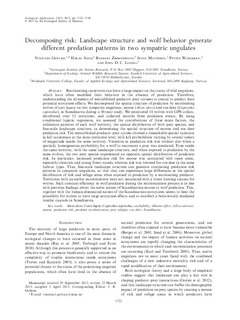Decomposing risk: landscape structure and wolf behavior generate different predation patterns in two sympatric ungulates
Gervasi, Vincenzo; Sand, Håkan; Zimmermann, Barbara; Mattisson, Jenny; Wabakken, Petter; Linnell, John D.C.
Journal article, Peer reviewed
Permanent lenke
http://hdl.handle.net/11250/134574Utgivelsesdato
2013Metadata
Vis full innførselSamlinger
Originalversjon
Gervasi, V., Sand, H., Zimmermann, B., Mattisson, J., Wabakken, P., & Linnell, J. D. (2013). Decomposing risk: Landscape structure and wolf behavior generate different predation patterns in two sympatric ungulates. Ecological Applications, 23(7), 1722-1734. doi: 10.1890/12-1615.1 10.1890/12-1615.1Sammendrag
Recolonizing carnivores can have a large impact on the status of wild ungulates,
which have often modified their behavior in the absence of predation. Therefore,
understanding the dynamics of reestablished predator–prey systems is crucial to predict their
potential ecosystem effects. We decomposed the spatial structure of predation by recolonizing
wolves (Canis lupus) on two sympatric ungulates, moose (Alces alces) and roe deer (Capreolus
capreolus), in Scandinavia during a 10-year study. We monitored 18 wolves with GPS collars,
distributed over 12 territories, and collected records from predation events. By using
conditional logistic regression, we assessed the contributions of three main factors, the
utilization patterns of each wolf territory, the spatial distribution of both prey species, and
fine-scale landscape structure, in determining the spatial structure of moose and roe deer
predation risk. The reestablished predator–prey system showed a remarkable spatial variation
in kill occurrence at the intra-territorial level, with kill probabilities varying by several orders
of magnitude inside the same territory. Variation in predation risk was evident also when a
spatially homogeneous probability for a wolf to encounter a prey was simulated. Even inside
the same territory, with the same landscape structure, and when exposed to predation by the
same wolves, the two prey species experienced an opposite spatial distribution of predation
risk. In particular, increased predation risk for moose was associated with open areas,
especially clearcuts and young forest stands, whereas risk was lowered for roe deer in the same
habitat types. Thus, fine-scale landscape structure can generate contrasting predation risk
patterns in sympatric ungulates, so that they can experience large differences in the spatial
distribution of risk and refuge areas when exposed to predation by a recolonizing predator.
Territories with an earlier recolonization were not associated with a lower hunting success for
wolves. Such constant efficiency in wolf predation during the recolonization process is in line
with previous findings about the naı¨ve nature of Scandinavian moose to wolf predation. This,
together with the human-dominated nature of the Scandinavian ecosystem, seems to limit the
possibility for wolves to have large ecosystem effects and to establish a behaviorally mediated
trophic cascade in Scandinavia.
